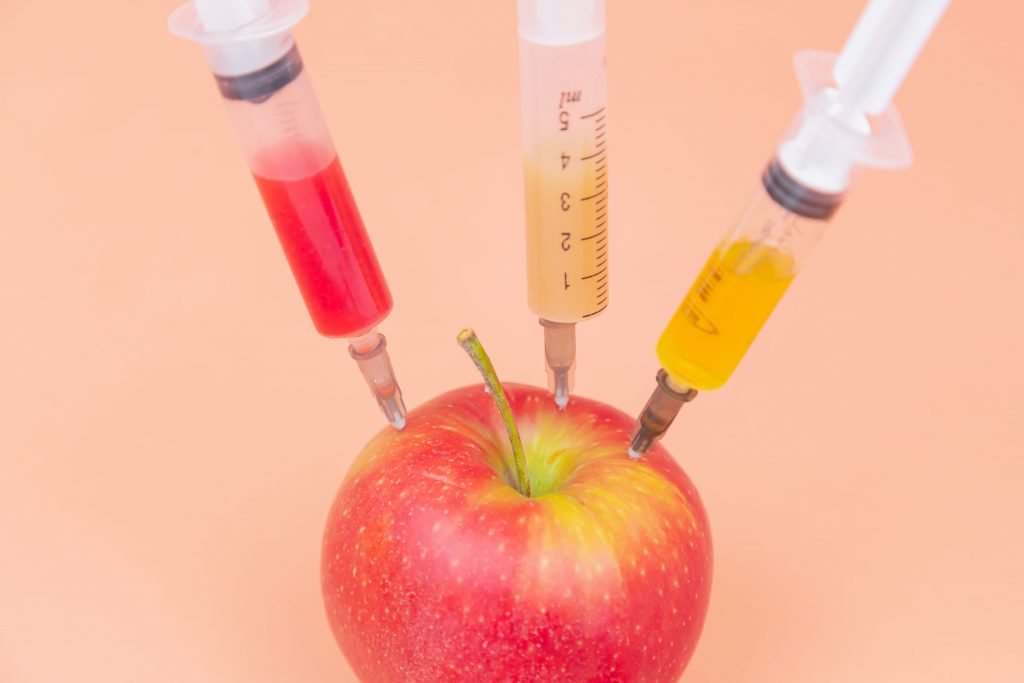
A great deal of myths and misconceptions surround so-called “Genetically Modified Organisms.” From health influencers advising consumers to stay away from them to pictures of fruits stabbed with syringes, these misconceptions have led to very negative views about GMOs amongst the general population. As such, it is an ongoing project in science communication to clarify these misconceptions.
Before it is possible to understand both the benefits and flaws of GMOs, it is important to understand what GMOs are. In a sense, humanity has been genetically modifying its crops since the dawn of agriculture. Modern corn is derived from a grass called teosinte that grows only a small number of small green kernels. Compared to its wild counterparts, even corn listed as non-GMO has a horrifying level of genetic modification.
Rather than a biological definition, GMOs have a legal distinction. The term mandated by the Food and Drug Administration is “bioengineered.” Bioengineered organisms are defined as organisms that contain DNA that they could not have received from conventional plant breeding. For example, crops such as BT corn are made through a process called transgenesis, the introduction of genes from other organisms into a desired host. Transgenesis is the only way by which any FDA approved GMOs have been made. Due to the specificity of this definition, other methods of genetic modification are often able to use non-GMO labels.
There are many such methods that are used. Selective breeding has been used for most of human history to produce and amplify crops with more beneficial traits. With enough patience and thoughtfulness, humanity has been able to achieve some truly incredible effects. Brassica oleracea is a plant that has been bred into many different cultivars, with broccoli and kale being just two of the dozens of cultivars listed by the North Carolina State University’s plant atlas. There are two large inefficiencies with this method. Due to its reliance on natural mutations in plants, certain plants are not able to be modified this way. It can also take a long time for the required mutations to appear.
In an attempt to speed up this process, humans have been using mutagens to induce mutation for the last century. This process, known as mutation breeding, allows for the large-scale introduction of new genetic material into a crop population. This increase in variance allows conventional breeding methods to push crops to have both higher productivity and higher tolerances to stress. Despite this being a very human endeavor to modify the genetics of a plant, all genes present in the final crop could have been obtained by conventional breeding techniques. As such, mutagenic crops do not have to disclose this fact to the consumer.
GMOs gain a great deal of precision over these conventional methods. Where mutation breeding uses random mutations, biological engineering inserts specific genes into a crop. There are three primary uses of GMOs: resistance to pests, resistance to herbicides and increased yield. When, in the 1990s, papaya ringspot virus (PRSV) nearly destroyed the Hawaiian papaya industry, a genetically engineered papaya known as the Rainbow papaya was engineered with resistance to PRSV. This additional resistance allowed the papaya industry to recover, and only minor differences in their nutritional values have been found. Roundup Ready (RR) sugar beets have added genes which give them increased resistance to glyphosate, a common herbicide. This herbicide resistance allows for farmers to plant crops closer together, reducing both land and herbicide usage. AquAdvantage salmon have been modified to include a growth hormone promoter from a faster growing fish called an ocean pout. The additional active growth hormone allows for AquAdvantage salmon to grow faster, requiring less total feed and land usage.
These positives shouldn’t imply that GMOs are without their issues, though. Due to the risk of crossbreeding with both wild and conventionally grown crops, the FDA has put large restrictions on the growing of genetically modified crops. In addition, due to the technological nature of these crops, they are eligible for patents. This means that biotechnology companies such as Monsanto are able to require very specific practices from farmers growing their crops. Farmers who choose to grow RR sugar beets are required by contract to remove any beets that flower. This can both reduce yield and increase costs for the farmer. Despite these restrictions on farmers, many farmers choose time and time again to grow genetically modified crops rather than conventional crops.
While there are valid reasons to be concerned about the biotechnological industry, most of the concerns raised about GMOs lack a scientific basis. Humans have been changing the genetic content of the plants and animals they cultivate since the beginning of agriculture. Every study on the nutritive quality of GMOs has shown that their nutritive value is well within the normal differences between different lines of traditionally grown crops. Ultimately, GMOs are a powerful tool to prevent food shortages.
